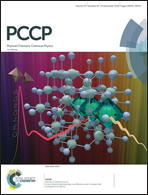Cyanine platelet single crystals: growth, crystal structure and optical spectra†
Abstract
Crystalline organic semiconducting materials are much in demand for multiple electronic and optoelectronic device applications. Here, solution grown ultrathin rhombic crystals of a trimethine carbocyanine anionic dye are used to establish relationships between structural and optical properties. The dye crystallized in the monoclinic space group P21/c featuring alternating layers of molecules in two different herringbone type patterns, with perchlorate counterions located mostly within one of the two layers. Micro transmittance spectroscopy revealed a broadened spectrum compared to those obtained in solution and in an amorphous thin film. Using polarized light, transmission spectroscopy revealed strong low-energy and weak high-energy bands polarized along the crystallographic b- and c-axis, respectively. Using the extended dipole approximation, significant exciton couplings are predicted between neighboring molecules in the crystal, of the order of the intrinsic monomer reorganization energies associated with nuclear relaxation after excitation, depicting a complex spectral scenario. The exciton coupling pattern explains the relative energies of the b- and c-polarized components but the observed intensities are opposite to expectations based on chromophore alignment within the crystal.



 Please wait while we load your content...
Please wait while we load your content...